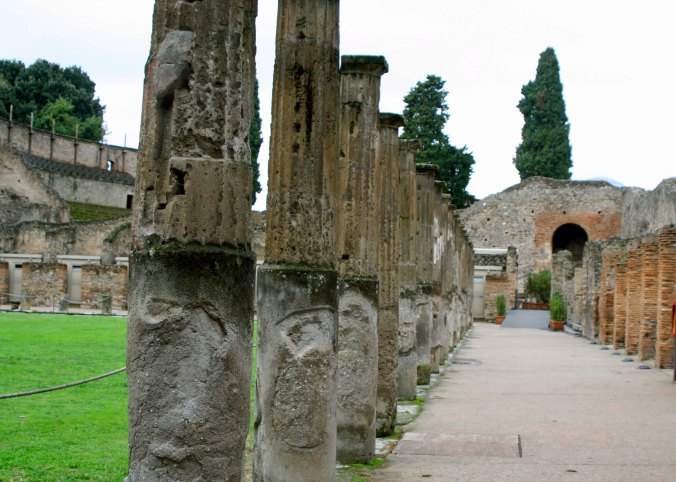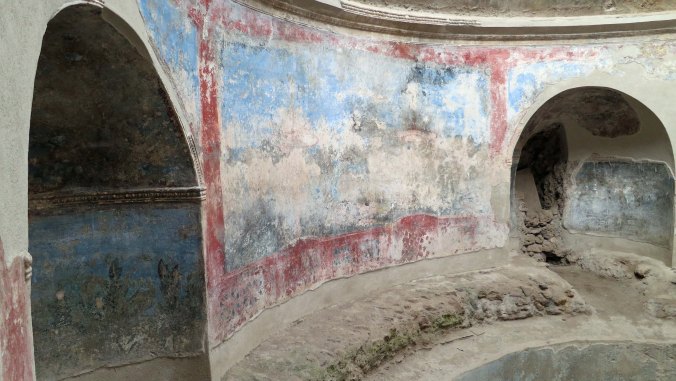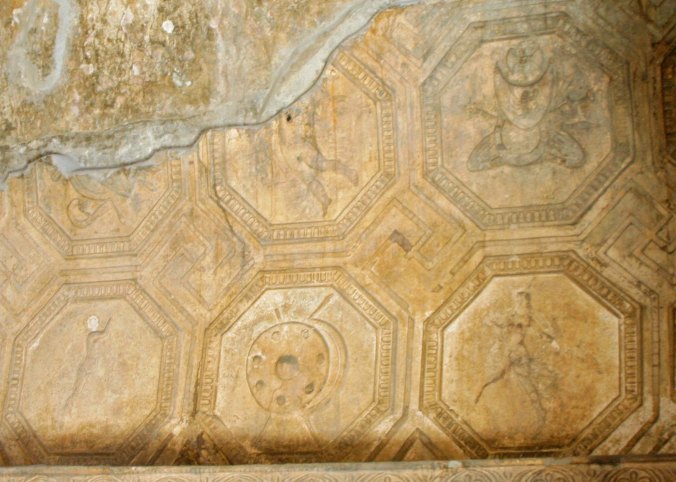
Buried under a pyroclastic flow of molten rock in 79 AD, the ruins of Pompeii have been well preserved. A large harbor on the Tyrrhenian Sea was located where the grass on the far right is now seen. Today, the sea is two miles away.
I have wandered through many ruins in my life ranging from the Anasazi cliff dwellings of the southwestern US to the Hindu temples of Bali. In all of these locations, you can feel the presence of ancient inhabitants… if you allow your imagination to run a little wild.
Nowhere, however, have I had a sense of people going about their everyday life as I did in Pompeii. The explosion of Mt. Vesuvius in 79 AD froze the city in time. It was easy for me to visualize the dead bodies cast in plaster and found throughout the city, coming to life at night, like the animated characters in Toy Story.
In my imagination, chariots raced up and down the streets, citizens stopped to relax in the public baths, bakers produced mouth-watering bread, satisfied customers raved about the girls at the Lupanare, worshippers stopped to pay their respects to Jupiter and Apollo, and people lined up for the Pompeii equivalent of fast-food. I could almost hear the clash of weapons as gladiators practiced at the gladiator school.
Today I will take you on a walk through the streets of Pompeii where all of these activities took place on the day before Mt. Vesuvius blew its top.

The clash of wooden weapons reverberated through the air as gladiators practiced on the field at the left. The hundred or so gladiators who trained at Pompeii were housed in rooms on the right. (Photo by Peggy Mekemson)

Pompeii’s theater, which could seat 5000 people, is located just beyond the gladiator school. Seats were separated by price and class. Poor folks got the nosebleed seats.

Streets in Pompeii were paved with large granite stones. The deep tracks were made by chariots, all of which had a standardized wheel base. As for the stones on top, you are looking at a cross walk or stepping-stones. These allowed people to avoid horse poop, and, even more interesting, to cross the roads when the streets were regularly flooded to remove horse droppings and other waste.

Large ovens such as this were used for baking bread. Can you smell it? The round object in front was used for grinding grain. Small rocks were included in the flour for free. I suspect dentists would be delighted.

Fast food, anyone? These large circles held pots of hot food. The residents of Pompeii could get a quick bite to eat here… just like we do at McDs. (Photo by Peggy Mekemson.)

A typical Pompeii street scene featuring stepping-stones, sidewalks, and shops. I was amazed by how well the city was planned.

Every Roman city had public baths for men and women. The baths at Pompeii are among the best preserved. Each bath came with heated floors and hot, warm and cold water. They were also extensively decorated. This bath had murals on the walls.

Even the ceilings of the baths at Pompeii were decorated. Note the details. Each circle contains a different subject including nudes, a shield and a chalice. (Photo by Peggy Mekemson)

I close with what, at first, appears to be abstract art but was actually a coiled snake. It had an interesting story. Our guide told us snakes were painted on the walls to keep men from urinating on them. Apparently peeing on a snake brought bad luck. (Photo by Peggy Mekemson)
NEXT BLOG: I will visit with the gods of Pompeii, plus the market, the forum and the basilica.

